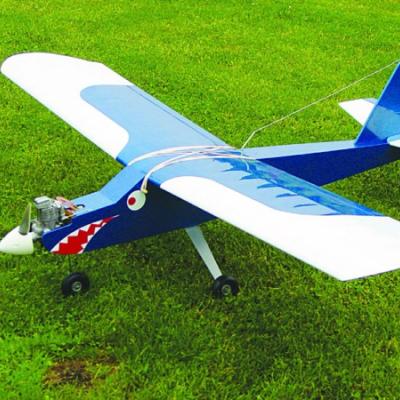
A typical safe starting point for almost any airplane is if the CG is placed at 25% of the mean aerodynamic wing chord (MAC). The farthest back the CG usually gets on a typical trainer is 33%, or one-third, of the MAC. See the graphic for an illustration of this. Flying wing and tailless models typically fly with the CG at 15%-20% of the MAC. On a constant-chord wing, the 25% point is exactly one-quarter of the way back from the leading edge (LE) to the trailing edge (TE). Most trainers are designed with constant-chord wings.

Once you have found the starting balance point, move equipment if necessary to make the airplane balance properly. When the balance point is incorrect, the first thing that typically gets moved is the battery pack for the radio. Most often the battery has to be moved forward under the tank to move the balance forward. If that isn’t enough, you may even consider using a heavier, larger-capacity battery. After all, nickel and cadmium are useful heavy metals, and lead is just dead weight.
If you must add nose weight, place it as far forward as practical so that less is necessary. The weights that mount to the crankshaft are not generally recommended. If, on the other hand, your airplane is nose-heavy to start with, it is slightly easier to move the battery and receiver aft. The receiver is relatively fragile in a crash (and expensive, compared to the battery), so keep the receiver behind the battery! If you must add tail weight, place it as far aft as you can, on the fuselage, because less will be necessary.
Take a good look at your airplane to make sure the wing and stabilizer are mounted exactly as described on the plans. You are looking for incorrect incidence angles, which could force you to counteract them with excessive amounts of elevator deflection.
One more thing: Make sure the elevator trim on the transmitter is centered and the elevator control surface is straight. That will require a control-linkage adjustment. You don’t want to run out of trim-lever movement because you didn’t set the elevator straight to begin with. That goes for all the other control surfaces too!
Going Flying
Most trainers are designed to climb at full throttle and fly in level cruise at a power setting just above half throttle without having to change the elevator trim. On takeoff your test pilot will take this into account and wait until the airplane is throttled back to cruise power before making any fine elevator-trim adjustments for level flight.
Now, the importance of knowing that the elevator was straight with the trim lever centered will become apparent. As you first put trim into the airplane, you already have some idea of what you are dealing with. Does it need up or down from the ideal, and roughly how much? That’s better than waiting until after landing to look and see that all that furious wiggling of the transmitter trim lever was just to get things straight!
Pitch Flight Testing
Now that the airplane is trimmed for level cruise, let’s do a couple simple tests. Smoothly advance the throttle to full. Without making elevator corrections, but still keeping the wings level with minimal, smooth aileron control inputs, watch the climb that results.
Is the climb too shallow and fast? This might be ideal for an advanced sport airplane, but for a trainer you want a solid climb with adequate airspeed.
Is the climb too steep? Watch to see if the climb is so steep that the airspeed has decayed.
Is it difficult to promptly correct the wind’s effects? If so, that is a sign that the airspeed is too low because of the steepness of the climb. In that case, you can do one of two things: make the airplane less speed sensitive by moving the CG aft and adding down-elevator trim or add more downthrust. If the airplane climbs too shallow, you would do the opposite.